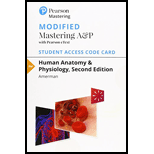
Which of the following are considered parts of the axial skeleton? (Circle all that apply.)
a. Pectoral girdle
b. Lower limb
c. Skull
d. Vertebral column
e. Pelvic girdle
f. Thoracic cage
Introduction:
The skeletal system provides the framework for the body. The human skeletonconsists of 270 bones at the time of birth, but the number decreases to 206 inadulthood because of the fusion of some bones. The human skeletal system is dividedinto two parts: axial skeleton, whichmaintainsan upright posture of the human body, and appendicular skeleton, whichconsists of limbs and girdles. Appendicular skeleton helps in the movement of the body.
Answer to Problem 1CYR
Correct answer:
The parts of the axial skeleton are skull, vertebral column, andthoracic cage.
Explanation of Solution
Justification/explanationfor the correct answer:
Options (c), (d), and (f) areskull, vertebral column, as well as thoracic cage, respectively. The axialskeleton consists of 80 bones. The skull is composed of 22 bones, out of which eightare cranial bones and 14 are facial bones, whichmake the framework for the face. The vertebral column is composed of 33 bones, out of which 24 bonessurround the spinal cord, and two inferior bones, namely, the sacrum (5 fused vertebrae) and coccyx (4 fused vertebrae), are fused with each other. The thoracic cage has 12 pairs of ribs, whichprotect the lungs and heart. Hence, options (c), (d), and (f) are correct.
Explanation for the incorrect answers:
Option (a) is pectoral girdle. Pectoral girdle surrounds and supports the upper limbs. Itcontains two bones: clavicle and scapula, and is not a part of the axial skeleton. So, it is an incorrect option.
Option (b) is lower limb. The lower limb consists of three parts, which are femur(thigh), tibia, and fibula (leg), and foot bone comprising tarsals, metatarsals, and phalanges. Theselimbs hold the upper part of the body. Theyhelp in locomotion and are not a part of the axial skeleton. So, it is an incorrect option.
Option (e) is pelvic girdle. Pelvic girdle consists of two pelvic bones and the sacrum. It supports the pectoral girdle. The pelvic bone consists of three fused bones, namely, ilium, ischium, and pubis. It is also not apart of the axial skeleton. So, it is an incorrect option.
Hence, options (a), (b), and (e) are incorrect.
Thus, it can be concluded that the skeletal system of a humancomprisestwo parts. The parts of the axial skeletonare skull, vertebral column, and thoracic cage. So, options (c), (d), and (f) are correct.
Want to see more full solutions like this?
Chapter 7 Solutions
Modified Masteringa&p With Pearson Etext -- Standalone Access Card -- For Human Anatomy And Physiology
- The axial skeleton consists of the ______, while the appendicular skeleton consists of the _____arrow_forward______are shock pads and flex points. a. Vertebrae b. Cervical bones c. Lumbar bones d. Intervertebral disksarrow_forwardThe carpal bones are a set of eight bones that make up the human wrist. These bones are part of which division of the skeleton? A. Compact skeleton B. Axial skeleton C. Subchondral skeleton D. Appendicular skeletonarrow_forward
- Coronal, Sagittal, and Lambdoid all describe areas of intersection of skull bones called: a. ) condyles b.) sutures c.) fossa d.) groove e.) protuberances The superior orbital fissure is a: Group of answer choices a. narrow, slit-like opening in the sphenoid b. small, round opening in the mandible bone c. shallow, basin like depression of the scapula d. rounded projection on the vertebraearrow_forwarda. Which of the following is part of the axial skeleton? A. shoulder bones B. femur - thigh bone C. foot bones D. skull bones B. Which of the following bones are part of the appendicular skeleton? A. sacrum B. humerus - arm bone C. ribs D. vertebrae c. Intervertebral discs contribute to the painful condition of disc herniation. Which option below correctly describes the anatomy of this condition? A. None of the above - as we age the annulus fibrosis gets stronger B. The nucleus pulposus weakens and the gel-like annulus fibrosis protrudes causing the herniation C. The annulus fibrosis weakens and the entire posterior portions of the fibrosis fold causing pain. D. The annulus fibrosis weakens and the gel-like nucleus pulposus protrudes causing the herniationarrow_forward
 Concepts of BiologyBiologyISBN:9781938168116Author:Samantha Fowler, Rebecca Roush, James WisePublisher:OpenStax College
Concepts of BiologyBiologyISBN:9781938168116Author:Samantha Fowler, Rebecca Roush, James WisePublisher:OpenStax College Human Biology (MindTap Course List)BiologyISBN:9781305112100Author:Cecie Starr, Beverly McMillanPublisher:Cengage Learning
Human Biology (MindTap Course List)BiologyISBN:9781305112100Author:Cecie Starr, Beverly McMillanPublisher:Cengage Learning Medical Terminology for Health Professions, Spira...Health & NutritionISBN:9781305634350Author:Ann Ehrlich, Carol L. Schroeder, Laura Ehrlich, Katrina A. SchroederPublisher:Cengage Learning
Medical Terminology for Health Professions, Spira...Health & NutritionISBN:9781305634350Author:Ann Ehrlich, Carol L. Schroeder, Laura Ehrlich, Katrina A. SchroederPublisher:Cengage Learning





